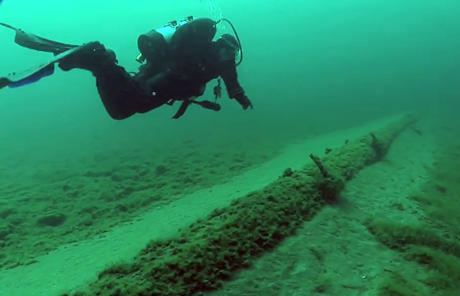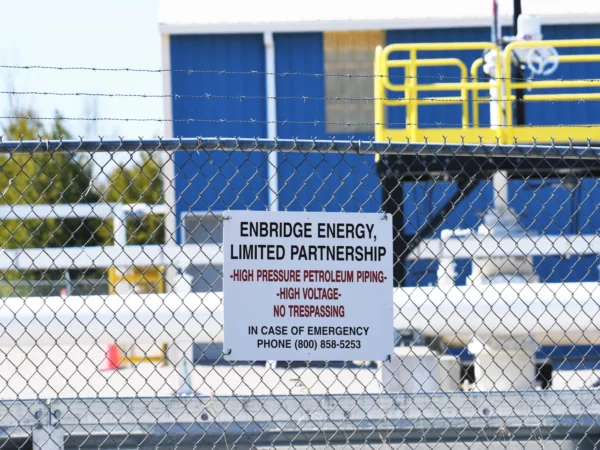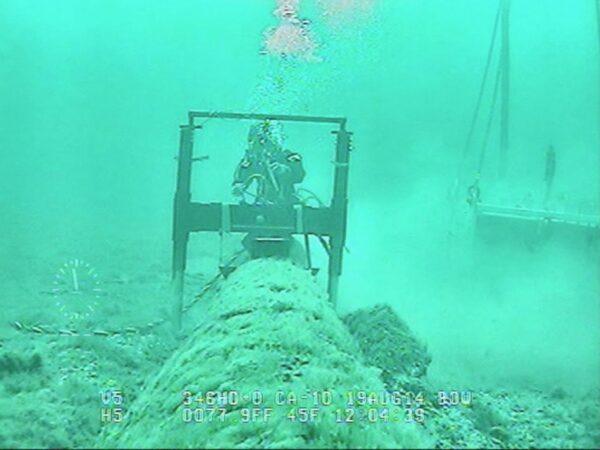
Legal agreement reached between Governor Snyder, Enbridge
People who oppose the Line 5 pipeline in the Straits of Mackinac woke up the Monday after Thanksgiving thinking they’d been given an early holiday gift: the shut-down of the controversial pipeline.
Headlines across the internet screamed “Line 5 to be shut down” – but many of the headlines were misleading.
It turns out it’s a temporary shutdown that will only take place along the 4.5 mile section of the pipeline near the Mackinac Bridge when there’s severe weather with waves more than 8 feet high.
But other parts of the new legal agreement announced by Governor Rick Snyder are definite steps forward, say people who both oppose and support the Line 5 pipeline which carries 23 million gallons of oil under the waters between the Upper and Lower Peninsula of Michigan.

Michigan Governor Rick Snyder, courtesy of Detroit Regional Chamber
Governor Snyder released the following statement to Great Lakes Now: “Business as usual by Enbridge is not acceptable and we are going to ensure the highest level of environmental safety standards are implemented to protect one of Michigan’s most valuable natural resources. The items required in this agreement are good strides forward. The state is evaluating the entire span of Enbridge’s Line 5 pipeline and its future, but we cannot wait for the analyses to be completed before taking action to defend our waterways.”
In a news conference at 11 am on November 27th, Executive Director of the Michigan Agency for Energy and co-chair of the Pipeline Safety Advisory Board Valerie Brader told Great Lakes Now , “Recent disclosures by Enbridge regarding damage to the Line 5 coating beneath the Straits of Mackinac have underscored the need for improved stewardship.”
Brader says, “This agreement requires specific actions with hard deadlines, to make certain there is the proper level of transparency, accountability and action on the part of Enbridge and the State. Under this agreement, the state will hire its own experts to work alongside Enbridge on many of these actions and monitor and review the company’s data.”
The report calls for – among other items – the following:
- Replacing the portion of Line 5 that crosses beneath the St. Clair River with a new pipe in a tunnel under the river
- Undertaking a study in conjunction with the state on the placement of a new pipeline in a tunnel beneath the Straits of Mackinac
- Temporarily shutting down the operation of Line 5 in the Straits during a period of sustained adverse weather conditions that would not allow an effective response to a potential spill.
- Requires the installation of the addition of technology like underwater cameras to better detect things like weaknesses in protective coating and to better monitor the pipeline underneath the Straits of Mackinac.
- Implement any technologies for better immediate response in the event of a spill or damage to the pipeline from an anchor vessel strike on line 5 beneath the Straits
- Implement ways to minimize oil spills at all Line 5 water crossings throughout the state of Michigan
- Come up with a definitive plan for the future of Line 5.

Valerie Brader Executive Director of the Michigan Agency for Energy, courtesy of michigan.gov
Brader says each of these actions has a specific deadline, and if Enbridge does not meet these requirements by the deadline, they would be considered in breach of the agreement.
In addition, Brader says the agreement calls for a decision to be made between the state and Enbridge about the future of Line 5 by August 15, 2018.
The 645-mile long pipeline runs from Superior, Wisconsin to Sarnia, Ontario. It transports about 540 barrels a day of light crude oil and natural gas liquids. The pipeline was built in 1953.
Michigan Department of Natural Resources Director Keith Creagh tells Great Lakes Now , “This agreement puts state and scientific experts shoulder to shoulder with Enbridge during significant studies and implementation. This will allow us to independently verify the company’s findings and make sure that any and all information is made available in a timely manner.”
Enbridge spokesman Ryan Duffy released this statement to Great Lakes Now : “Many Michiganders have joined Governor Snyder in expressing, with increasing frequency, concerns regarding the safety of Line 5 in the Straits. Enbridge not only is hearing those concerns, we are listening. Most important, we are taking actions to address these concerns.
We hope the agreement is a step in a positive direction to demonstrate our commitment to doing the right thing to serve Michigan and protect the waters of the Great Lakes. The Great Lakes are a treasure that must be preserved now and for future generations.“
But some environmental activists and even members of the Pipeline Safety Advisory Board say they find the Governor’s and Enbridge’s actions confusing.

Mike Shriberg, Great Lakes regional executive director of the National Wildlife Federation, courtesy of nwf.org
Great Lakes Regional Executive Director for the National Wildlife Federation Mike Shriberg who is a member of the Pipeline Safety Advisor Board tells Great Lakes Now there are many positive parts of this report, including the August 15th goal to execute an agreement about the future of the Line 5 Pipeline. But he says, “the state is tipping its hand, saying ‘our preference is for a tunnel under the straits as opposed to the current pipeline laying at the bottom.’ That actually cuts out the best option for the state which is to decommission Line 5.”
Shriberg adds that the way the announcement of this agreement was made was rather strange. He tells Great Lakes Now he found out about the agreement Monday morning – the same way the media was informed of it. “I’m dismayed an agreement was signed between the Governor and Enbridge without any consultation with the board itself,” says Shriberg. He says, “I wasn’t provided with any input on this.”
Liz Kirkwood, Executive Director of FLOW in Traverse City tells Great Lakes Now Governor Snyder’s announcement is “stunning”. She says the Governor “undermined a process he himself created by executing an agreement that lays the groundwork for an underwater tunnel below the Great Lakes without even consulting with the Pipeline Safety Advisory Board.”

Liz Kirkwood, Executive Director of FLOW, courtesy of flowforwater.org
Kirkwood says it appears that “Governor Snyder has brokered a deal with Enbridge, in spite of the fact that this is the company that has been misleading and lying to state agencies for 3 years regarding their safety efforts to install anchors, which has caused bare spots in the protective coating. “
In addition, Kirkwood says this agreement indicates “the State of Michigan under this governor is going to determine the fate of Line 5 because there will be a new agreement decided by August 15th, 2018, in advance of the gubernatorial election.”
Executive Director of the Michigan Agency for Energy and co-chair of the Pipeline Safety Advisory Board Valerie Brader tells Great Lakes Now, “This agreement is by no means a final decision on the future of Line 5.”
However, Brader also added, “shutting down the pipeline is still on the table.”
Greatlakesnow.org will have more reactions and analysis to this agreement in the coming weeks.
To look at the agreement reached between Governor Snyder and Enbridge visit the Pipeline Safety Advisory Board website.




